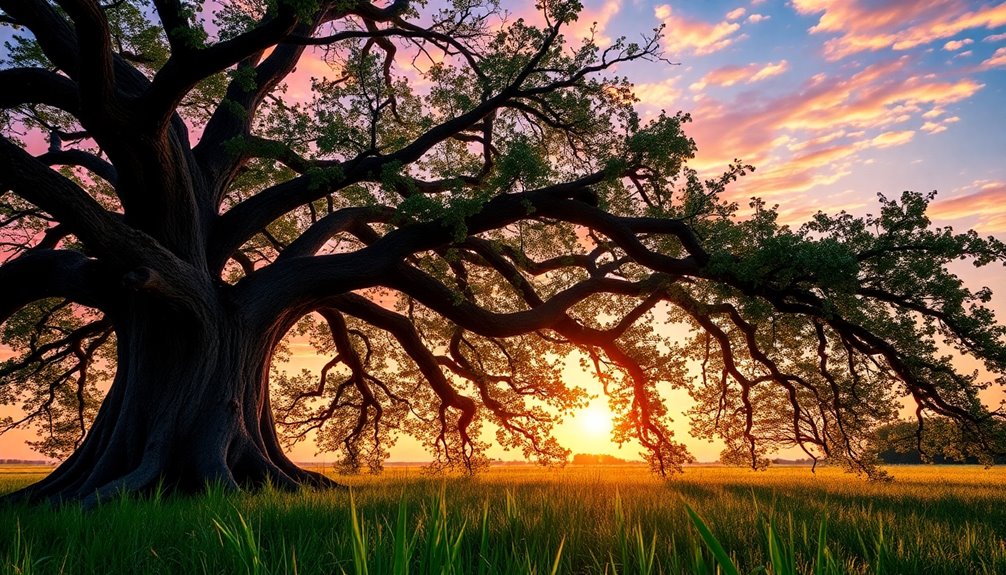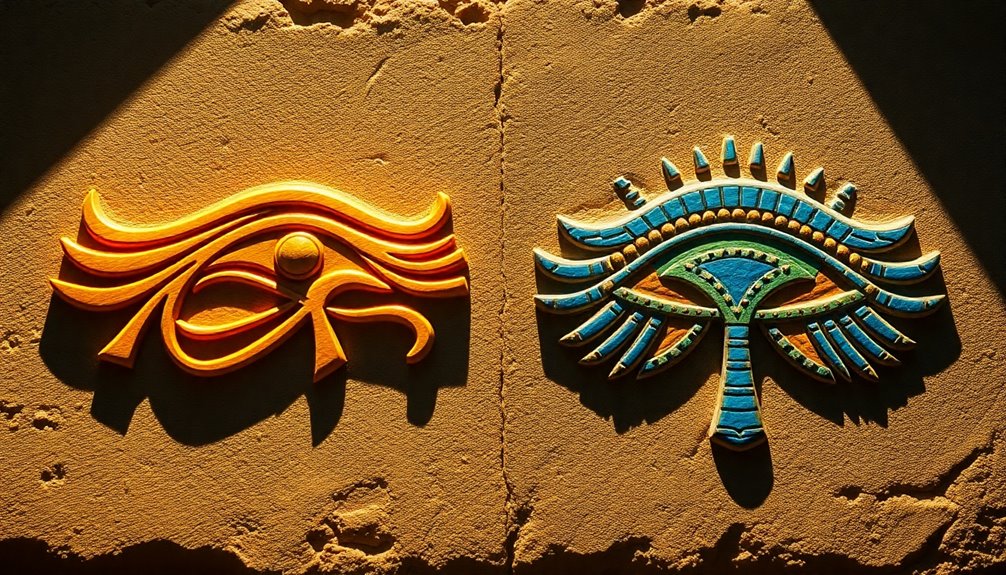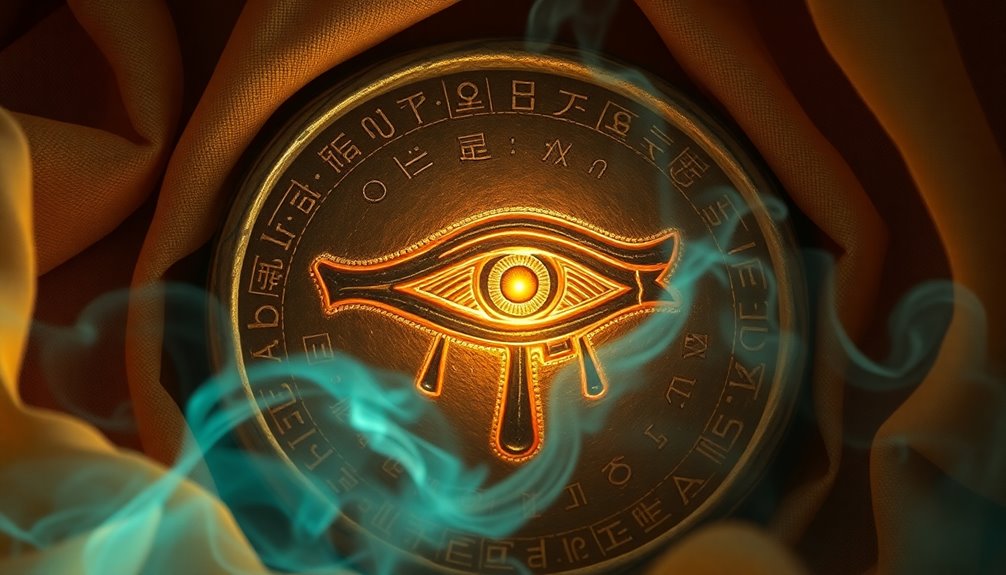The Tree of Life is a powerful symbol that represents the interconnectedness of all living things. It serves as a metaphor for growth, transformation, and renewal, appearing in various cultures and spiritual traditions around the world. From ancient mythologies to modern interpretations, this symbol captures the balance between the physical and spiritual domains. In religious contexts, it signifies eternal life and divine wisdom. Scientifically, it offers insights into evolutionary relationships among species. Its rich cultural significance makes it a universal emblem of life. Stay tuned to explore its fascinating history and meanings across different cultures.
Key Takeaways
- The Tree of Life symbolizes the interconnectedness of all living things, representing growth, transformation, and renewal across various cultures.
- In religious contexts, it signifies divine wisdom and eternal life, appearing in texts like the Bible, Quran, and Kabbalah.
- Historically, it has roots in ancient civilizations, symbolizing immortality and the balance between material and spiritual realms.
- Evolutionarily, the Tree of Life illustrates relationships among species, tracing common ancestry and highlighting biodiversity.
- Psychologically, it represents personal growth and spiritual development, linking individual journeys to a broader cosmic connection.
Overview of the Tree of Life

The Tree of Life stands as a powerful emblem across cultures, symbolizing the intricate web that connects all living things. This universal symbol represents the interconnectedness of life forms, bridging the gap between the physical and spiritual domains.
You'll find the Tree of Life featured prominently in various religious texts, like the Bible and the Quran, where it symbolizes divine wisdom and eternal life.
In Norse mythology, Yggdrasill serves as the Tree of Life, linking nine worlds and embodying cosmic significance and the thirst for knowledge. Ancient civilizations, including Mesopotamia, Egypt, and Greece, revered this motif for its representation of life, growth, and interconnectedness.
Artistic interpretations of the Tree of Life also thrive today, with works like Gustav Klimt's mural and Mozambican sculptures showcasing its enduring relevance.
When you explore its various manifestations, you'll see how it transcends cultural boundaries, reminding us of our shared existence. The Tree of Life invites you to reflect on the connections that bind us together, encouraging a deeper understanding of both the physical and spiritual aspects of life.
Cultural Significance and Variations
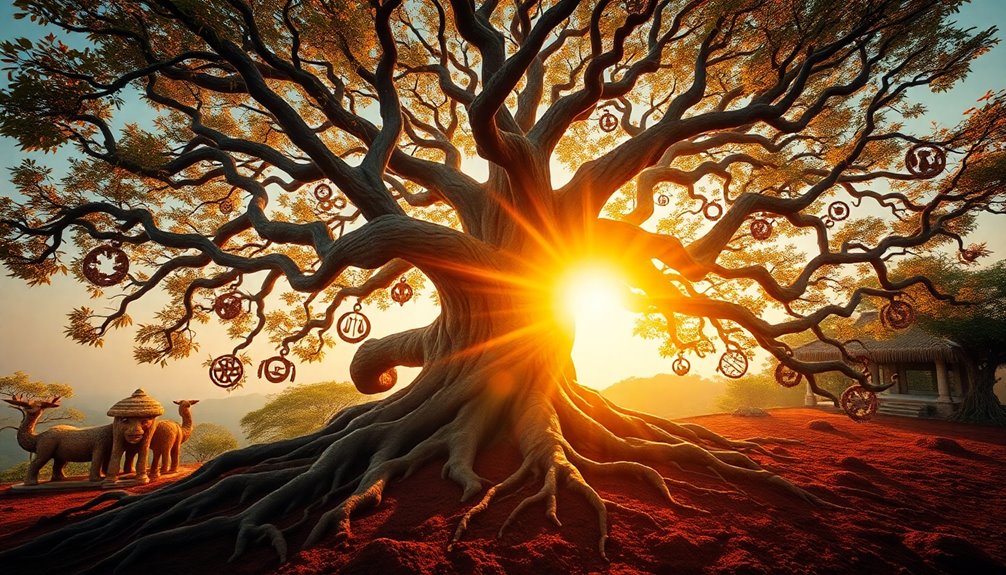
Across the globe, the Tree of Life takes on a rich tapestry of meanings that reflect the unique beliefs and values of different cultures.
In Norse mythology, Yggdrasill stands as the central Tree of Life, linking nine worlds and embodying cosmic significance. Odin's sacrifice at its roots emphasizes the pursuit of knowledge within this spiritual tradition.
The Celtic Tree of Life beautifully illustrates interconnectedness, with its roots symbolizing the underworld, the trunk the physical domain, and the branches the heavens. This depiction highlights the cycle of life, death, and rebirth that characterizes many cultural narratives.
In Mesoamerican cultures, the Mayan Tree of Life, known as Yaxche, connects the underworld and heavens, conveying a belief in a unified cosmos.
Similarly, Native American traditions feature trees that bridge Earth with spiritual domains, reinforcing this theme of connection.
Ancient Egyptian mythology also presents the Tree of Life as a symbol linked to Osiris, representing resurrection and the intricacies of life and death.
This widespread significance across diverse cultures showcases the enduring power of the Tree of Life as a universal archetype.
Historical Context and Origins
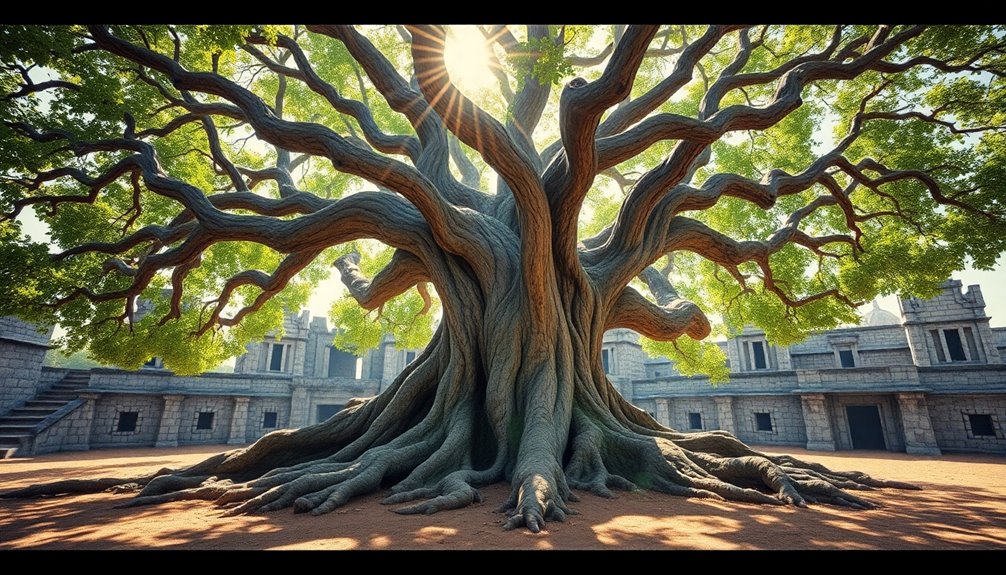
The Tree of Life motif traces back to ancient sacred tree symbols found in various civilizations, like Mesopotamia and Egypt, where they linked life to the divine.
You'll see how mythological representations, from Yggdrasill in Norse mythology to the Biblical trees in Eden, shaped our understanding of existence.
Over time, these symbols evolved, reflecting changing beliefs and values across cultures.
Ancient Sacred Tree Motifs
Sacred tree motifs have long captivated human imagination, serving as powerful symbols across various ancient civilizations. These trees often embody the connection between life and the spiritual world, illustrating humanity's quest for understanding.
In Mesopotamia, the Assyrian sacred tree represented kingship, emphasizing the divine order between rulers and the cosmos. The Egyptian Tree of Life, associated with Osiris, highlights the interplay between life and death, showcasing how ancient cultures viewed existence as cyclical.
In Norse mythology, Yggdrasill serves as the cosmic tree linking Nine Worlds, its branches reaching the heavens while its roots explore the underworld. This motif underlines the tree's role in the universe's structure, connecting diverse domains of existence.
Meanwhile, in Mesoamerica, the Mayan Tree (Yaxche) links the underworld and heavens, reinforcing the spiritual significance trees held across cultures.
Daoist mythology introduces the pantao peach, a sacred fruit that symbolizes immortality, ripening every 3,000 years. These motifs often include supernatural guardians, reflecting a deep-rooted desire for eternal life and spiritual connection, resonating through time and across civilizations.
Mythological Representations Across Cultures
Rooted in various mythologies, representations of the Tree of Life reveal deep cultural significance across civilizations. This powerful symbol signifies connections between the divine and earthly domains.
In ancient Mesopotamia and Egypt, it symbolizes divine order and immortality, frequently linked to deities like Osiris. Meanwhile, in Norse mythology, Yggdrasill serves as the central Tree of Life, connecting Nine Worlds and maintaining cosmic balance, illustrating the quest for knowledge.
The Mesoamerican Tree of Life, Yaxche, embodies the interconnectedness of life, bridging the underworld and heavens, reflecting indigenous cultures' spiritual beliefs.
In Celtic traditions, the Tree of Life symbolizes the cyclical nature of existence, with its roots reaching into the underworld, its trunk grounded in reality, and its branches stretching toward the heavens, representing growth and renewal.
In Buddhism, the Bodhi tree—the spot where Siddhartha reached enlightenment—serves as a powerful representation of the Tree of Life, emphasizing spiritual awakening and divine connection.
Through these diverse mythological lenses, the Tree of Life continues to symbolize new life, unity, and transformation across cultures, reminding you of the intricate web of existence.
Evolution of Symbolism Over Time
Throughout history, the Tree of Life has transformed in meaning and significance, reflecting the evolving beliefs and values of different civilizations. In ancient Mesopotamia, this symbol represented divine order, acting as a bridge between life and death. It was a reminder of the balance between good and evil, connecting humanity's journey through existence.
In Biblical texts, you find the Tree of Life in the Garden of Eden, where it symbolizes eternal life and divine wisdom, standing in contrast to the Tree of Knowledge. This duality reveals humanity's struggle with choices and morality.
Norse mythology introduces Yggdrasill, a cosmic tree linking nine worlds, emphasizing interconnectedness and the search for knowledge.
Meanwhile, in Chinese Daoist beliefs, the pantao peach embodies the desire for eternal life, showcasing how the Tree of Life has evolved across cultures.
Modern artistic interpretations, such as Gustav Klimt's "The Tree of Life," further illustrate its cultural significance. They merge historical meanings with contemporary themes, ensuring that the Tree of Life remains a powerful symbol of existence, connection, and the quest for understanding throughout time.
Religious Interpretations and Symbolism
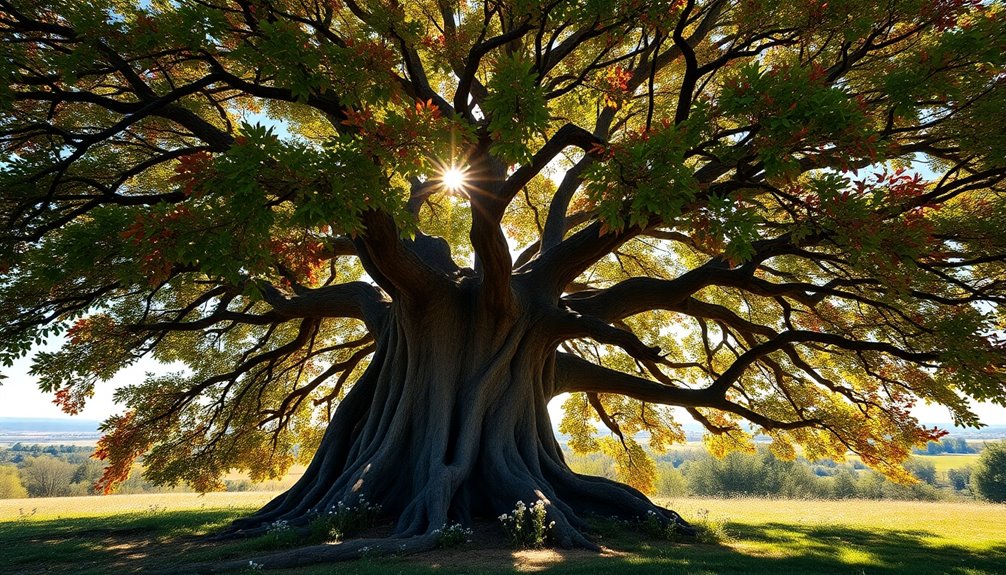
When you explore the Tree of Life in various religious contexts, you'll find rich symbolism and profound meanings.
From its significance in Christian theology as a source of eternal life to the Kabbalistic interpretation that guides spiritual growth, the tree takes on many forms.
Additionally, the Quran's Tree of Immortality reflects themes of divine mercy, adding another layer to this intricate symbol across cultures.
Biblical Context and Significance
The Tree of Life, as depicted in the Bible, serves a profound purpose within both the Garden of Eden and the broader context of Christian theology. Located alongside the Tree of Knowledge of Good and Evil, the Tree of Life symbolizes divine provision and eternal life, contrasting the forbidden wisdom represented by the Tree of Knowledge.
In Revelation 22:2, the Tree of Life is described as bearing twelve kinds of fruit, emphasizing its role in providing spiritual nourishment and healing for the nations. This imagery highlights the Tree of Life's significance in the journey of faith.
It represents redemption and reflects Jesus as the source of eternal life, bridging humanity and divinity. As you explore this concept, consider how the Tree of Life embodies the promise of restoration and hope, offering a path to spiritual fulfillment.
In essence, the Tree of Life stands as a powerful symbol of divine grace, inviting you to partake in its fruits and embrace the eternal connection it signifies.
Through its presence in the Garden of Eden, it reminds you of the balance between knowledge and the divine sustenance available for your spiritual journey.
Kabbalah's Tree of Life
Kabbalah's Tree of Life serves as a profound symbol within Jewish mysticism, representing the diverse attributes of God and the pathways to spiritual enlightenment. At its core, the Tree consists of ten Sefirot, each embodying different aspects of existence, such as wisdom, understanding, and beauty. These Sefirot act as channels of divine energy, connecting the spiritual and physical domains, guiding you toward greater self-discovery.
As you explore the Tree of Life, you'll notice how the diagram illustrates the flow of energy from the divine source downward. The pathways between the Sefirot symbolize the interconnectedness of all creation, reminding you that every action has a ripple effect. Kabbalistic teachings emphasize that by understanding the Tree, you can experience personal transformation and deepen your relationship with the divine.
Moreover, the Tree reflects your soul's journey, illustrating the process of spiritual ascent and the quest for unity with God. Through self-awareness and ethical living, you can navigate this intricate structure, ultimately achieving spiritual enlightenment and a harmonious existence within the universe.
Embracing Kabbalah's Tree of Life can profoundly impact your spiritual path.
Quranic Immortality Symbolism
In the Quran, the Tree of Immortality stands as a powerful symbol of eternal life, reflecting divine mercy bestowed upon humanity. This tree connects the physical and spiritual domains, representing the journey of the soul toward enlightenment and ultimate salvation.
When Adam and Eve consumed the fruit of the Tree, they gained awareness of good and evil, emphasizing obedience to God's commands and the importance of repentance.
Islamic traditions interpret the Tree of Immortality as a source of spiritual nourishment. It signifies the profound relationship between divine guidance and human experience, inviting believers to align their lives with God's will.
The imagery of the tree serves as a reminder that faith and righteous actions are essential for attaining paradise.
Moreover, the Quranic portrayal underscores that eternal life isn't just a reward but a path that requires dedication and commitment to spiritual growth.
By engaging with the teachings surrounding the Tree of Immortality, you can cultivate a deeper understanding of divine mercy and the significance of your choices in this life.
Embrace this symbolism to guide your journey toward a life filled with purpose and connection to the divine.
Scientific Perspective on Life
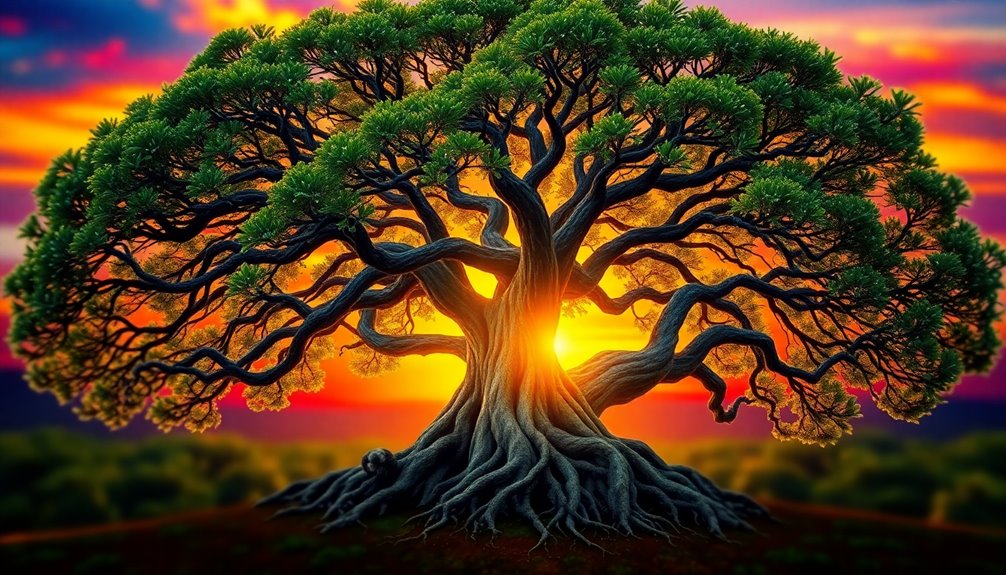
A fascinating way to understand life is through the scientific Tree of Life, which illustrates the evolutionary relationships that connect all living organisms. It traces back to a common ancestor that existed around 3.5 billion years ago. This metaphor serves as a powerful symbol for biodiversity, emphasizing how the branches reach out, creating a vast network of life on Earth.
Through phylogenetics, scientists study these relationships by analyzing genetic evidence, mapping how species have diverged over time.
Here are some key points to reflect on:
- Common ancestry: All life forms share a lineage, highlighting our interconnectedness.
- Speciation: Populations evolve and adapt, leading to the branching of lineages.
- DNA sequencing: Modern technology enhances our understanding of evolutionary history.
Artistic Representations and Impact
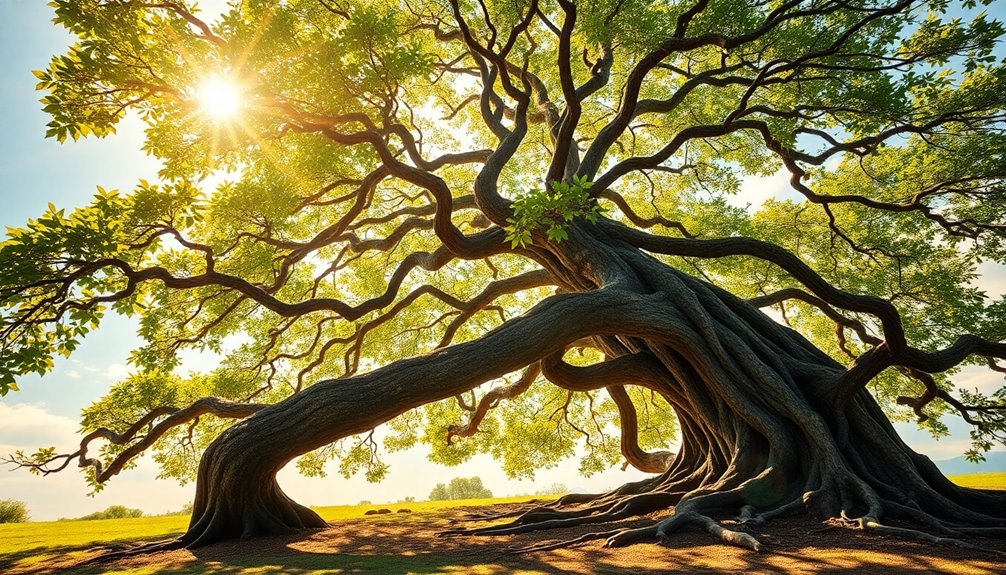
The Tree of Life isn't just a scientific concept; it's also a rich source of inspiration for artists across cultures and time periods. This mystical tree connects different domains, manifesting in a variety of artistic representations that showcase its powerful symbol of interconnectedness.
Take Gustav Klimt's "The Tree of Life, Stoclet Frieze," for example; its intricate design and vibrant colors symbolize unity and the cycle of life. The concept of cultural intelligence can enhance our understanding of how different societies interpret the Tree of Life through their unique lenses. This artistic expression often reflects spiritual principles that resonate with the values of love and compassion found in various teachings. The significance of traditional healing practices in Aboriginal culture also connects to notions of growth and interconnectedness, much like the way individuals seek to heal from narcissistic relationships that disrupt their emotional well-being.
In Mozambique, a sculpture aptly named "Tree of Life" transforms weapons into tools, representing themes of peace and transformation after civil war. You'll also find the Tree of Life motif in countless cultural artworks, emphasizing resilience and growth.
Terrence Malick's acclaimed 2011 film, "The Tree of Life," further explores universal themes of family and spirituality, blending art and storytelling in a visually stunning way.
Contemporary artists continue to draw from this powerful symbol, incorporating it into jewelry, murals, and installations that convey messages of healing and unity. The fruit of these artistic endeavors enriches our understanding of the Tree of Life, making it a timeless emblem for generations to come. Additionally, the predictive modeling used in educational data mining can help identify artistic trends and influences, further bridging the gap between art and technology.
Animal and Botanical Symbolism
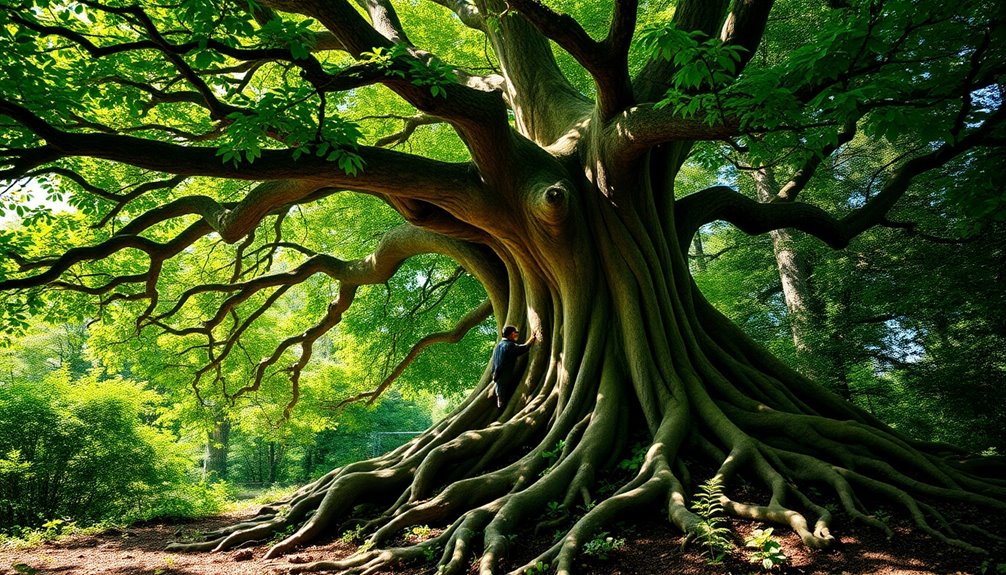
Various cultures interpret the Tree of Life through distinct animal and botanical symbolism, each adding layers of meaning to this ancient concept. For instance, in Norse mythology, the world tree Yggdrasill is home to powerful animals like the eagle and hawk, symbolizing wisdom and vision.
Meanwhile, the Biblical narrative introduces the snake, representing temptation and knowledge.
Botanical symbolism also plays a significant role in understanding the Tree of Life. Consider these elements:
- Fruits: The type of fruit varies across cultures; while the Bible mentions apples, Norse tales highlight berries from Yggdrasill.
- Roots and branches: These elements symbolize stability, strength, and growth, reflecting interconnectedness among all living beings.
- Baobab tree: In African traditions, this revered tree is celebrated for its mystical properties and connection to ancestral spirits.
Additionally, the concept of vibrational alignment can be explored in relation to the Tree of Life, illustrating how our energies resonate with the universal truths embodied in these symbols.
Together, these animal and botanical symbols enrich your understanding of the Tree of Life, illustrating how diverse cultures convey essential truths about existence and our place in the universe.
Embrace this symbolism, and you may find deeper connections within your own life.
Shamanic and Spiritual Perspectives
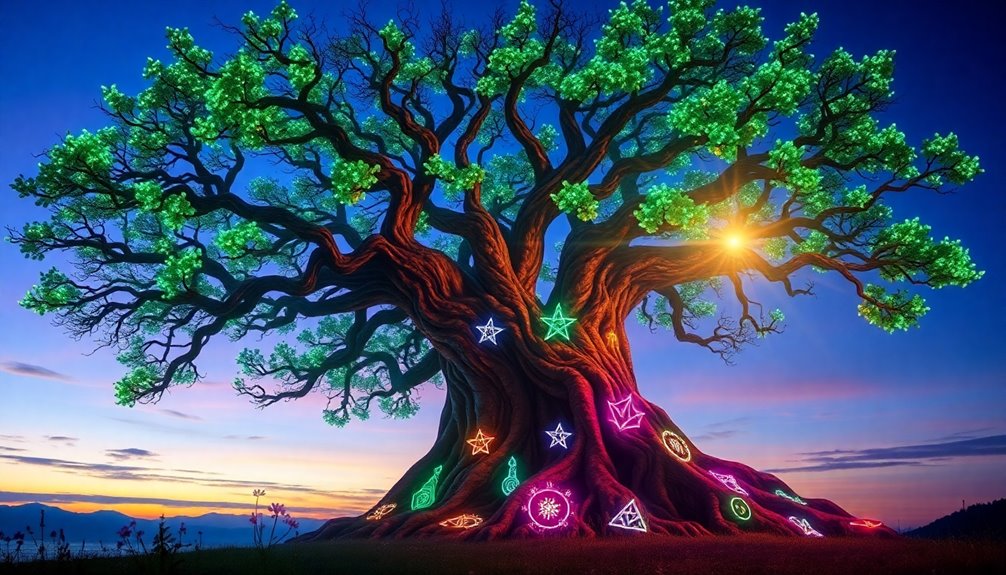
Shamanic and spiritual perspectives on the Tree of Life add a profound layer to its meaning, emphasizing its role as a bridge between spheres. In shamanic cosmology, the Tree of Life acts as a Cosmic Tree that connects the Underworld, Middle World, and Above World. This connection serves as a pathway for your spiritual journeys and initiations.
You'll find that shamans often use the Tree of Life metaphorically to access different territories during healing practices. Climbing the Tree symbolizes your spiritual ascent and connection to higher consciousness.
In the Minoan culture, the Tree of Life was central to their labyrinth, highlighting the necessity of connecting with divinity for personal transformation. Through shamanic traditions, this symbol embodies connections to power animals and guides, facilitating healing and insight during spiritual ceremonies.
When viewed through the lens of depth psychology, the Tree of Life represents continuous growth and your journey toward the true self. It emphasizes the importance of spiritual development, inviting you to explore and nurture your inner landscape as you set out on transformative experiences.
Interfaith Spirituality and Healing
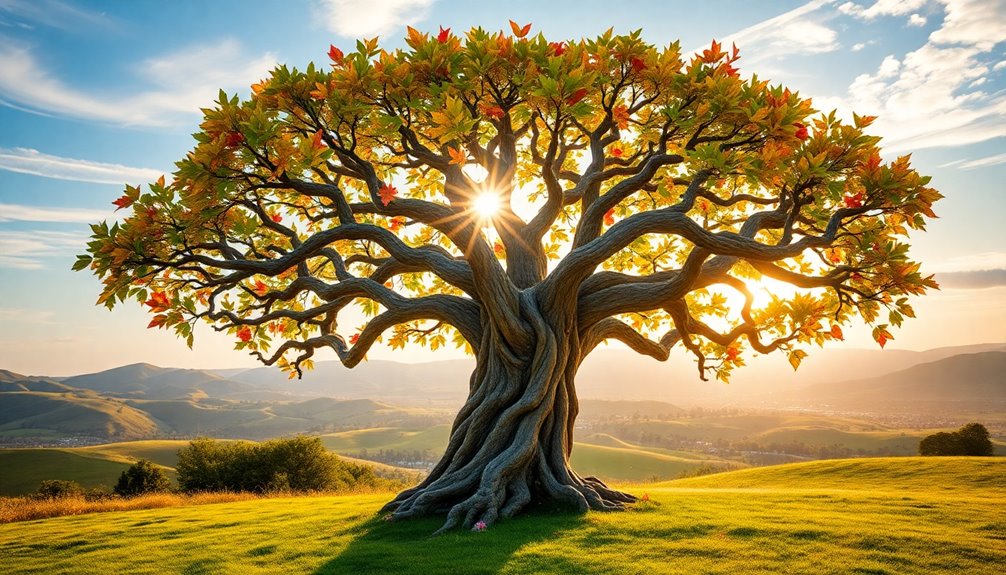
Interfaith spirituality fosters a rich tapestry of understanding, where diverse religious traditions come together to recognize shared principles. By embracing the Tree of Life, you tap into a symbol that represents interconnectedness and the aspiration toward divine understanding. This approach not only promotes tolerance but also highlights the potential for healing across different faiths.
Here are some ways interfaith spirituality contributes to healing:
- Cultural and Spiritual Survival: It nurtures coexistence through the recognition of shared values.
- Psycho-Spiritual Practices: Initiatives often utilize teachings from the Tree of Life to foster personal growth.
- Community Outreach: Ongoing dialogue bridges gaps, facilitating shared experiences among diverse groups.
Historical examples, like the interfaith communities in medieval Spain, showcase the transformative power of collaboration. Through these efforts, you can cultivate a deeper understanding of others, leading to collective reconciliation.
Engaging in interfaith spirituality not only enriches your personal journey but also contributes to a broader healing process, reminding us that our paths may differ, yet we all seek the same divine understanding. Embracing this interconnectedness can lead to profound healing in our communities.
Frequently Asked Questions
What Is the Meaning Behind the Tree of Life Symbol?
The Tree of Life symbol represents the interconnectedness of all living things and the cycles of existence.
You'll find it embodies growth, wisdom, and resilience, reminding you of your personal journey.
It serves as a bridge between earthly experiences and higher spiritual domains, illustrating stability and strength.
When you encounter this symbol, think of it as a reflection of your own development and connection to both nature and the divine.
Can Christians Wear the Tree of Life Symbol?
Wearing the Tree of Life symbol can feel like wrapping yourself in a warm embrace of faith and connection.
If you're a Christian, you might find that this emblem resonates with your beliefs about eternal life and divine wisdom.
It can serve as a reminder of your relationship with God and the interconnectedness of all creation.
However, it's important to reflect on your personal convictions and the symbol's significance in your spiritual journey.
What Is the Biblical Meaning of the Tree of Life?
The biblical meaning of the Tree of Life revolves around eternal life and divine sustenance.
When you explore Genesis and Revelation, you'll see it symbolizes God's grace and mercy, offering salvation to those who follow His commandments.
In Psalm 1, it represents righteousness, illustrating how the righteous flourish in God's presence.
Ultimately, it's a powerful metaphor for connection to the divine and the promise of everlasting life through faith.
What Does the Tree Symbolize Spiritually?
The Tree of Life symbolizes spiritual growth and interconnectedness in various traditions.
When you explore its meaning, you'll find it represents the link between the physical and spiritual domains. Its roots signify stability, grounding you, while its branches reach for higher understanding and enlightenment.
Fundamentally, it reminds you of your potential for growth and transformation, encouraging you to seek wisdom and connection with the divine in your own journey.
Conclusion
In fundamental nature, the Tree of Life stands as a powerful reminder of our interconnectedness and shared journey through existence. Its branches reach across cultures and beliefs, intertwining stories that resonate in our hearts. Just like a tree weathering storms, we too can endure and thrive, drawing strength from our roots. Embrace this universal symbol and let it inspire you to grow, connect, and nurture the bonds that tie us all together in this beautiful tapestry of life.

